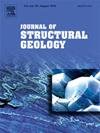Discrete-element numerical simulations of thrust-related folding: Insights into back-limb deformation
IF 2.9
2区 地球科学
Q2 GEOSCIENCES, MULTIDISCIPLINARY
引用次数: 0
Abstract
The theory of thrust-related folding has significantly enhanced our comprehension of the kinematic evolution of folds, especially those associated with fault ramps. Despite extensive research into the deformation mechanisms of the fore-limb in the hanging wall folds, the factors influencing back-limb deformation remain relatively underexplored. This study employs a series of discrete-element simulations to investigate the evolution of ramp-related folding, particularly focusing on the factors governing the development of back-thrusts. Comparative analyses reveal diverse deformation styles within the hanging wall of a ramp fold. Notably, when the upper layer exhibits significantly greater strength relative to the lower layer, and an intermediate décollement exists between them, decoupled deformation occurs, characterized by back-thrusting predominantly in the lower layer. This phenomenon is analogous to the deep thrust belts beneath the Shizigou anticline in the western Qaidam Basin, northern Tibetan Plateau, where multiple hydrocarbon-bearing layers have been identified. The findings offer significant insights into the mechanisms of thrust-related folding, thereby improving efficient hydrocarbon exploration in relevant regions. Furthermore, unlike the commonly reported nucleation of a fault ramp from the basal décollement or at an intermediate level, our observations indicate initiation from the shallow section. The detailed mechanism underlying such differential deformation warrant further investigation.
与推力相关的折叠的离散元数值模拟:对后肢变形的洞察
逆冲相关褶皱理论极大地提高了我们对褶皱运动演化的理解,特别是与断坡有关的褶皱。虽然对上盘褶皱前肢变形机制研究较多,但对后肢变形影响因素的探讨相对较少。本研究采用一系列离散元模拟来研究坡道相关折叠的演变,特别关注控制后冲发展的因素。对比分析揭示了斜坡褶皱上盘的多种变形形式。值得注意的是,当上层的强度明显大于下层,并且两者之间存在一个中间的变截面时,就会发生解耦变形,主要表现为下层的反冲。这一现象与青藏高原北部柴达木盆地西部狮子沟背斜下的深部冲断带相似,发现了多个含油气层。这一发现为研究逆冲相关褶皱机制提供了重要见解,从而提高了相关地区油气勘探的效率。此外,与通常报道的断层斜坡的成核来自基底或中间水平不同,我们的观察表明起核来自浅层。这种差异变形背后的详细机制值得进一步研究。
本文章由计算机程序翻译,如有差异,请以英文原文为准。
求助全文
约1分钟内获得全文
求助全文
来源期刊

Journal of Structural Geology
地学-地球科学综合
CiteScore
6.00
自引率
19.40%
发文量
192
审稿时长
15.7 weeks
期刊介绍:
The Journal of Structural Geology publishes process-oriented investigations about structural geology using appropriate combinations of analog and digital field data, seismic reflection data, satellite-derived data, geometric analysis, kinematic analysis, laboratory experiments, computer visualizations, and analogue or numerical modelling on all scales. Contributions are encouraged to draw perspectives from rheology, rock mechanics, geophysics,metamorphism, sedimentology, petroleum geology, economic geology, geodynamics, planetary geology, tectonics and neotectonics to provide a more powerful understanding of deformation processes and systems. Given the visual nature of the discipline, supplementary materials that portray the data and analysis in 3-D or quasi 3-D manners, including the use of videos, and/or graphical abstracts can significantly strengthen the impact of contributions.
 求助内容:
求助内容: 应助结果提醒方式:
应助结果提醒方式:


